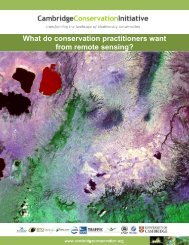CONSERVING BIODIVERSITY & DELIVERING ECOSYSTEM SERVICES
conserving biodiversity & delivering ecosystem services
conserving biodiversity & delivering ecosystem services
Create successful ePaper yourself
Turn your PDF publications into a flip-book with our unique Google optimized e-Paper software.
The Ministry of Local Development is responsible for the<br />
implementation of local development programmes and<br />
projects through decentralised local governance systems. The<br />
Local Self Governance Act 1999 entrusts local bodies to make<br />
decisions which will affect the lives of the people. The Act also<br />
empowers local bodies such as District Development<br />
Committees (DDC) and Village Development Committees<br />
(VDC) to manage natural resources within their jurisdiction<br />
and mobilise both human and financial resources. However,<br />
there has been overlap of roles and responsibilities with other<br />
Government line agencies in the management and use of<br />
resources, and this has sometimes resulted in difficulty in<br />
coordinating effective management of biodiversity and<br />
ecosystem services at the site level. One example is the<br />
Jagdishpur Reservoir Important Bird Area (IBA), which is also a<br />
Ramsar Site, and which is managed by the District Forest<br />
Office and the District Irrigation Office for completely<br />
different purposes.<br />
VDC members can make important decisions about the local use<br />
of natural resources. These members attend a stakeholder<br />
workshop at Rara National Park to discuss the use of resources by<br />
different people (David Thomas)<br />
Legislation, policies and plans—relevant to conserving<br />
biodiversity and delivering ecosystem services—in Nepal<br />
Enactment of National Park and Wildlife Conservation Act, 1973<br />
National Park and Wildlife Conservation Rules, 1974<br />
The National Forestry Policy (NFP),1976<br />
Leased Forest Rules, 1978<br />
Watershed Conservation Act,1982<br />
King Mahendra Trust for Nature Conservation Act, 1982<br />
Soil and Watershed Conservation Regulation, 1985<br />
National Conservation Strategy, 1987<br />
Nepal Environmental Policy and Action Plan (NEPAP), 1993<br />
Forestry Policy, 1992<br />
Hydropower Development Policy, 1992<br />
Industrial Policy, 1992<br />
National Shelter Policy, 1996<br />
Buffer Zone Management Regulation, 1996<br />
National Solid Waste Management Policy, 1996<br />
Environment Protection Act, 1996<br />
Environmental Protection Rules, 1997<br />
Buffer Zone Management Guidelines, 1999<br />
Formulation of Sustainable Development Agenda for Nepal<br />
(SDAN), 2002<br />
Nepal Biodiversity Strategy, 2002<br />
Nepal Biodiversity Strategy Implementation Plan, 2006–2010<br />
Water Resources Strategy, 2002<br />
National Wetland Policy, 2003<br />
Leasehold Forestry Policy Guidelines, 2003<br />
National Action Program on Land Degradation and<br />
Desertification, 2004<br />
National Agricultural Policy, 2004<br />
Community Forestry Guidelines, 1996 revised in 2002 and 2005<br />
National Water Plan 2005<br />
Agro-biodiversity Policy, 2007<br />
National Adaptation Programme of Action (NAPA), 2010<br />
Climate Change Policy, 2011<br />
Water Resources of Nepal-Climate Change, 2011<br />
The Ministry of Local Development and local bodies allocate<br />
budgets to implement a wide range of local development<br />
initiatives concerned with, for example, drinking water, rural<br />
roads, irrigation, micro hydroelectricity and other communityidentified<br />
small-scale projects. The local bodies also generate<br />
income from natural resources within their jurisdiction.<br />
However, many of the projects do not consider negative<br />
impacts on the environment and the values of ecosystem<br />
services which may be lost.<br />
Moving to a more sustainable future<br />
Attaining the right balance between use and<br />
conservation is always challenging but nonetheless<br />
necessary. The following are some proposed solutions to<br />
remove barriers to moving in this direction:<br />
■ A stronger policy commitment and growing<br />
realisation among planners on the need for<br />
integrating environment and development<br />
■ More coordinated policy-making taking into account<br />
all the international conventions, facilitating<br />
environmental standards, mainstreaming<br />
environmental issues in development programs, and<br />
monitoring compliance<br />
■ A growing recognition of the importance of a multistakeholder<br />
approach in environmental planning and<br />
management<br />
■ Strengthening, expanding and improving good<br />
practices like community forestry to make them more<br />
inclusive, integrated and sustainable<br />
■ Controlling unsustainable commercial exploitation of<br />
benefits from ecosystem goods and services, thereby<br />
putting people and the planet before profit<br />
SOURCE Drawn from NPC (2011) Nepal Status Paper—United Nations Conference<br />
on Sustainable Development 2012 (Rio+20): Synopsis. Kathmandu: National<br />
Planning Commission, Government of Nepal.




